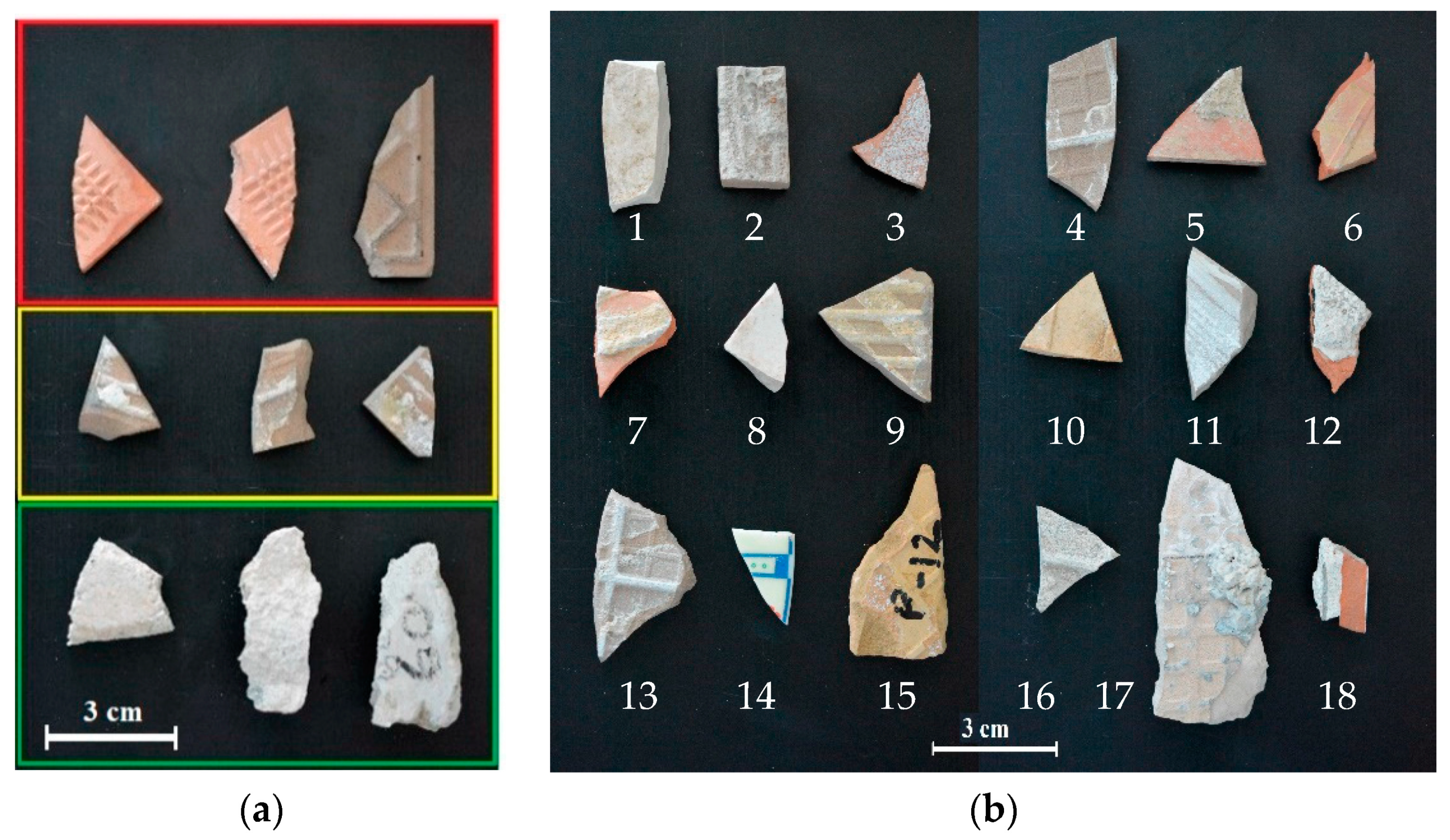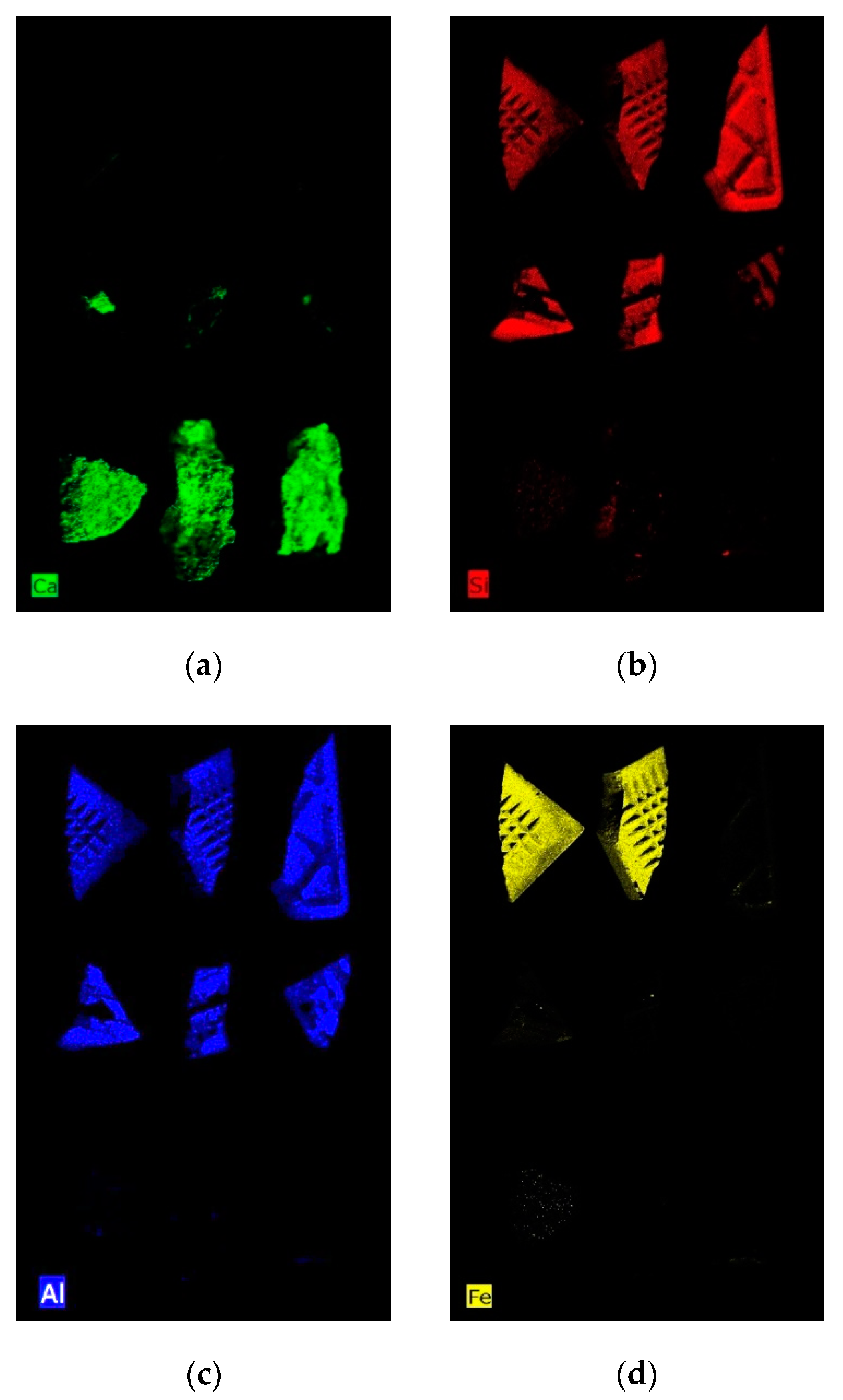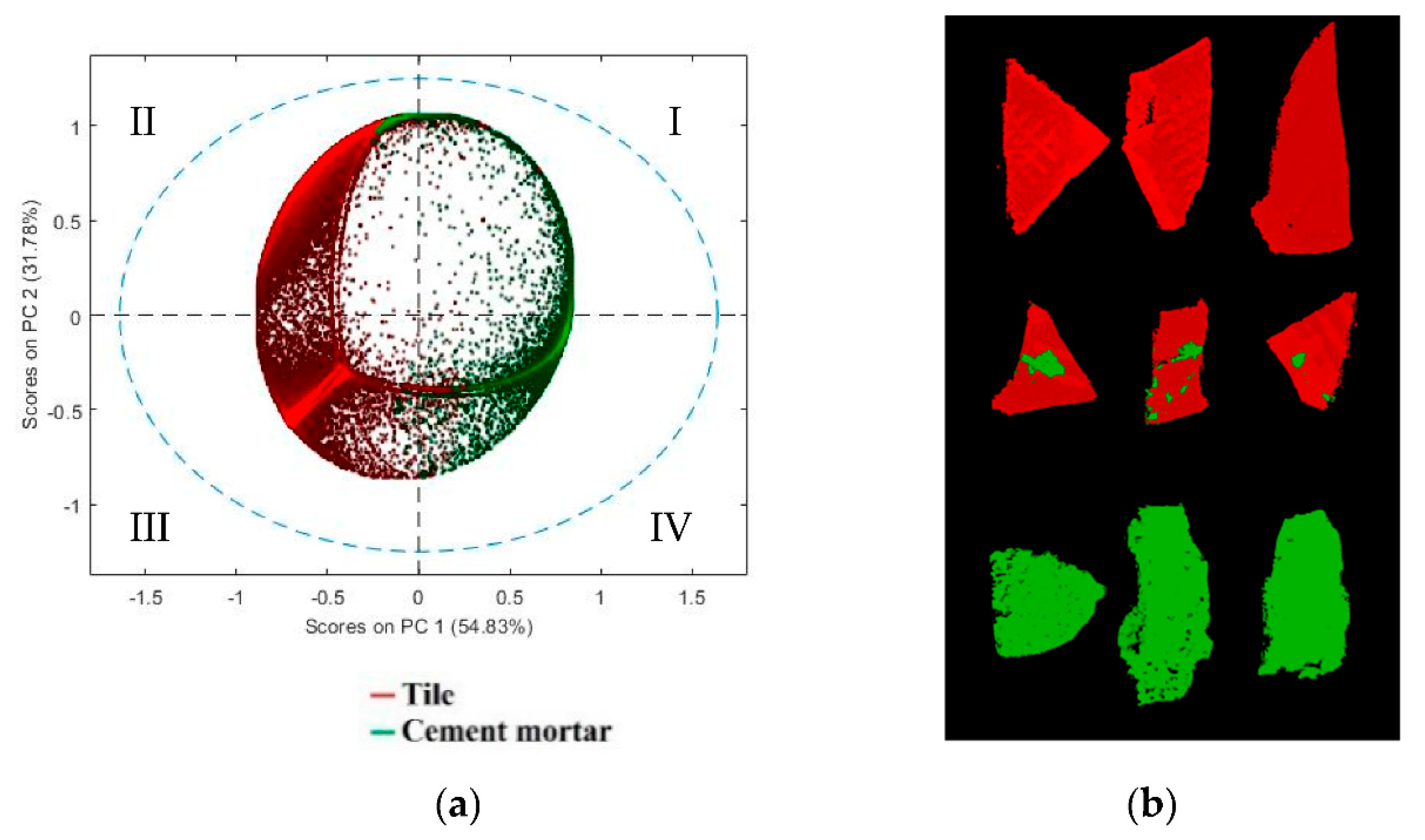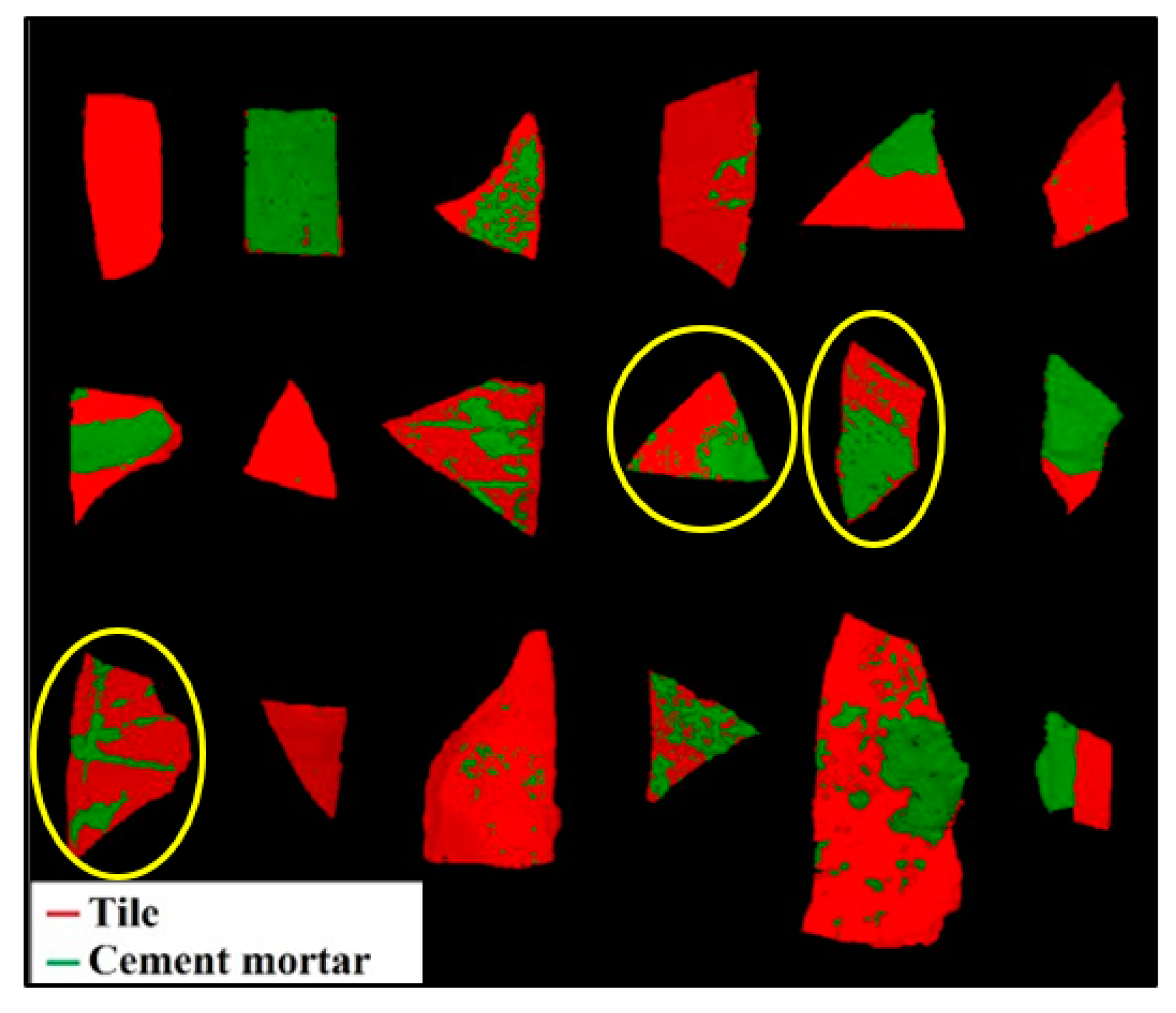Recycling-Oriented Characterization of Post-Earthquake Building Waste by Different Sensing Techniques
Abstract
:1. Introduction
2. Materials and Methods
2.1. Investigated Samples
2.2. Micro-X-ray Fluorescence
2.3. Hyperspectral Imaging
2.4. Data Handling and Analysis
2.4.1. Spectra Pre-Processing
2.4.2. Principal Components Analysis (PCA)
2.4.3. Partial Least Square Discriminant Analysis (PLS-DA)
3. Results and Discussion
3.1. Micro-XRF Results
3.2. Hyperspectral Imaging Results
3.3. Comparison of Micro-XRF Results and HSI Prediction
4. Conclusions
Author Contributions
Funding
Institutional Review Board Statement
Informed Consent Statement
Data Availability Statement
Conflicts of Interest
References
- Reinhart, D.; McCreanor, P. Disaster debris management–planning tools. US Environ. Prot. Agency Reg. IV 1999, 4, 1–31. [Google Scholar]
- Brown, C.; Milke, M.; Seville, E. Disaster waste management: A review article. Waste Manag. 2011, 31, 6. [Google Scholar] [CrossRef] [Green Version]
- Xiao, J.; Xie, H.; Zhang, C. Investigation on building waste and reclaim in Wenchuan earthquake disaster area. Resour Conserv. Recycl. 2017, 61, 109–117. [Google Scholar] [CrossRef]
- Tam, V.W.Y.; Soomro, M.; Evangelista, A.C.J. A Review of Recycled Aggregate in Concrete Applications (2000–2017). Constr. Build. Mater. 2018, 172, 272–292. [Google Scholar] [CrossRef]
- Rao, A.; Jha, K.N.; Misra, S. Use of Aggregates from Recycled Construction and Demolition Waste in Concrete. Resour. Conserv. Recycl. 2007, 50, 71–81. [Google Scholar] [CrossRef]
- Silva, R.V.; de Brito, J.; Dhir, R.K. Properties and Composition of Recycled Aggregates from Construction and Demolition Waste Suitable for Concrete Production. Constr. Build. Mater. 2014, 65, 201–217. [Google Scholar] [CrossRef]
- Xiao, J.; Li, W.; Fan, Y.; Huang, X. An Overview of Study on Recycled Aggregate Concrete in China (1996–2011). Constr. Build. Mater. 2012, 31, 364–383. [Google Scholar] [CrossRef]
- Yang, K.H.; Chung, H.S.; Ashour, A.F. Influence of Type and Replacement Level of Recycled Aggregates on Concrete Properties. ACI Mater. J. 2008, 105, 289–296. [Google Scholar]
- Binici, H. Effect of Crushed Ceramic and Basaltic Pumice as Fine Aggregates on Concrete Mortars Properties. Constr. Build. Mater. 2007, 21, 1191–1197. [Google Scholar] [CrossRef]
- Huang, Q.; Zhu, X.; Xiong, G.; Wang, C.; Liu, D.; Zhao, L. Recycling of Crushed Waste Clay Brick as Aggregates in Cement Mortars: An Approach from Macro- and Micro-Scale Investigation. Constr. Build. Mater. 2021, 274, 122068. [Google Scholar] [CrossRef]
- Daniyal, M.; Ahmad, S. Application of Waste Ceramic Tile Aggregates in Concrete. Int. J. Innov. Res. Sci. Eng. Technol. 2015, 4, 2347–6710. [Google Scholar]
- Topcu, I.B.; Canbaz, M. Utilization of crushed tile as aggregate in concrete. Iran. J. Sci. Technol. Trans. A Sci. 2007, 31, 561–565. [Google Scholar]
- Sekar, M. Partial Replacement of Coarse Aggregate by Waste Ceramic Tile in Concrete. Int. J. Res. Appl. Sci. Eng. Technol. 2017, 5, 473–479. [Google Scholar] [CrossRef]
- Camacho, J.S.; dos Santos Felipe, A.; Aris Parsekian, G.; Paz Dornelles, V.; Nelson Elias, C. Adhesion of Ceramic Tile Coating System on Concrete Block Wall. Constr. Build. Mater. 2020, 244, 118278. [Google Scholar] [CrossRef]
- Chand, G. Partial Replacement of Aggregate with Ceramic Tile in Concrete. Ph.D. Thesis, Jawaharlal Nehru Technological University, Kakinada, India, 2017. [Google Scholar]
- Sivachandiran, N.; Magesh, A. An Experimental Analysis of Partial Replacement of Coarse Aggregate by Waste Ceramic Tile in Concrete. J. Pure Appl. Math. 2018, 119, 167–177. [Google Scholar]
- Nedeljković, M.; Visser, J.; Šavija, B.; Valcke, S.; Schlangen, E. Use of Fine Recycled Concrete Aggregates in Concrete: A Critical Review. J. Build. Eng. 2021, 38, 102196. [Google Scholar] [CrossRef]
- Braymand, S.; Roux, S.; Fares, H.; Déodonne, K.; Feugeas, F. Separation and Quantification of Attached Mortar in Recycled Concrete Aggregates. Waste Biomass Valorization 2017, 8, 1393–1407. [Google Scholar] [CrossRef]
- Gruber, F.; Wollmann, P.; Schumm, B.; Grählert, W.; Kaskel, S. Quality Control of Slot-Die Coated Aluminum Oxide Layers for Battery Applications Using Hyperspectral Imaging. J. Imaging 2016, 2, 12. [Google Scholar] [CrossRef] [Green Version]
- Pelosi, C.; Rubino, G.; Capobianco, G.; Lanteri, L.; Agresti, G.; Bonifazi, G.; Lo Monaco, A. A Multi-Technique Approach to Evaluate the Surface Properties of Heat-Treated Chestnut Wood Finished with a Water-Based Coating. Coatings 2021, 11, 706. [Google Scholar] [CrossRef]
- Thumm, A.; Riddell, M.; Nanayakkara, B.; Harrington, J.; Meder, R. Near infrared hyperspectral imaging applied to mapping chemical composition in wood samples. J. Near Infrared Spectrosc. 2010, 18, 507–515. [Google Scholar] [CrossRef]
- Bonifazi, G.; Capobianco, G.; Serranti, S. Hyperspectral imaging and hierarchical PLS-DA applied to asbestos recognition in construction and demolition waste. Appl. Sci. 2019, 9, 4587. [Google Scholar] [CrossRef] [Green Version]
- Serranti, S.; Palmieri, R.; Bonifazi, G. Hyperspectral imaging applied to demolition waste recycling: Innovative approach for product quality control. J. Electron. Imaging 2015, 24, 043003. [Google Scholar] [CrossRef] [Green Version]
- Hollstein, F.; Cacho, Í.; Arnaiz, S.; Wohllebe, M. Challenges in automatic sorting of construction and demolition waste by hyperspectral imaging. In Advanced Environmental, Chemical, and Biological Sensing Technologies XIII; International Society for Optics and Photonics: Washington, DC, USA, 2017. [Google Scholar] [CrossRef] [Green Version]
- Suciu, G.; Beceanu, C.; Scheianu, A.; Petre, I. Construction and demolition waste based on the automatic recycling management. Int. Multidiscip. Sci. GeoConf. SGEM 2020, 20, 237–244. [Google Scholar]
- Chen, J.; Li, G. Prediction of moisture content of wood using Modified Random Frog and Vis-NIR hyperspectral imaging. Infrared Phys. Technol. 2020, 105, 103225. [Google Scholar] [CrossRef]
- Mallet, A.; Pérémé, M.; Awhangbo, L.; Charnier, C.; Roger, J.M.; Steyer, J.P.; Bendoula, R. Fast at-line characterization of solid organic waste: Comparing analytical performance of different compact near infrared spectroscopic systems with different measurement configurations. Waste Manag. 2021, 126, 664–673. [Google Scholar] [CrossRef]
- Chen, Y.; Xu, Z.; Tang, W.; Hu, M.; Tang, D.; Zhai, G.; Li, Q. Identification of various food residuals on denim based on hyperspectral imaging system and combination optimal strategy. Artif. Intell. Agric. 2021, 5, 125–132. [Google Scholar] [CrossRef]
- Bonifazi, G.; Capobianco, G.; Serranti, S. A hierarchical classification approach for recognition of low-density (LDPE) and high-density polyethylene (HDPE) in mixed plastic waste based on short-wave infrared (SWIR) hyperspectral imaging. Spectrochim. Acta Part A Mol. Biomol. Spectrosc. 2018, 198, 115–122. [Google Scholar] [CrossRef]
- Lorenzo-Navarro, J.; Serranti, S.; Bonifazi, G.; Capobianco, G. Performance Evaluation of Classical Classifiers and Deep Learning Approaches for Polymers Classification Based on Hyperspectral Images. In Advances in Computational Intelligence; Rojas, I., Joya, G., Catala, A., Eds.; Springer: Cham, Switzerland, 2015. [Google Scholar] [CrossRef]
- Serranti, S.; Gargiulo, A.; Bonifazi, G. Characterization of post-consumer polyolefin wastes by hyperspectral imaging for quality control in recycling processes. Waste Manag. 2011, 31, 2217–2227. [Google Scholar] [CrossRef]
- Singh, N.; Hui, D.; Singh, R.; Ahuja, I.P.S.; Feo, L.; Fraternali, F. Recycling of plastic solid waste: A state of art review and future applications. Compos. Part B Eng. 2017, 115, 409–422. [Google Scholar] [CrossRef]
- Zheng, Y.; Bai, J.; Xu, J.; Li, X.; Zhang, Y. A discrimination model in waste plastics sorting using NIR hyperspectral imaging system. Waste Manag. 2018, 72, 87–98. [Google Scholar] [CrossRef] [PubMed]
- Markiewicz, J.; Tobiasz, A.; Kot, P.; Muradov, M.; Shaw, A.; Al-Shamma’a, A. Review of surveying devices for structural health monitoring of cultural heritage buildings. In In Proceedings of the 2019 12th International Conference on Developments in Esystems Engineering (DeSE), Kazan, Russia, 7–10 October 2019; pp. 597–601. [Google Scholar]
- Picollo, M.; Cucci, C.; Casini, A.; Stefani, L. Hyper-spectral imaging technique in the cultural heritage field: New possible scenarios. Sensors 2020, 20, 2843. [Google Scholar] [CrossRef] [PubMed]
- Bonifazi, G.; Capobianco, G.; Palmieri, R.; Serranti, S. Hyperspectral imaging applied to the waste recycling sector. Spectrosc. Eur. 2019, 31, 8–11. [Google Scholar]
- Copani, G.; Picone, N.; Colledani, M.; Pepe, M.; Tasora, A. Highly evolvable E-waste recycling technologies and systems. In Factories of the Future; Springer: Cham, Switzerland, 2019; pp. 109–128. [Google Scholar]
- Liu, Y.; Pu, H.; Sun, D.W. Hyperspectral Imaging Technique for Evaluating Food Quality and Safety during Various Processes: 41A Review of Recent Applications. Trends Food Sci. Technol. 2017, 69, 25–35. [Google Scholar] [CrossRef]
- Geladi, P.H.J.H.; Grahn, H.; Burger, J. Multivariate images, hyperspectral imaging: Background and equipment. In Techniques and Applications of Hyperspectral Image Analysis; John Wiley & Sons, Ltd.: San Francisco, CA, USA, 2007; pp. 1–15. [Google Scholar]
- Serranti, S.; Bonifazi, G. Hyperspectral Imaging and Its Applications. In Optical Sensing and Detection IV; International Society for Optics and Photonics: Washington, DC, USA, 2016. [Google Scholar]
- Bonifazi, G.; Palmieri, R.; Serranti, S. Evaluation of attached mortar on recycled concrete aggregates by hyperspectral imaging. Constr. Build. Mater. 2018, 169, 835–842. [Google Scholar] [CrossRef]
- Lotfi, S.; Rem, P. Recycling of end-of-life concrete fines into hardened cement and clean sand. J. Environ. Prot. 2016, 7, 934–950. [Google Scholar] [CrossRef] [Green Version]
- Herrador, R.; Pérez, P.; Garach, L.; Ordóñez, J. Use of Recycled Construction and Demolition Waste Aggregate for Road Course Surfacing. J. Transp. Eng. 2012, 138, 182–190. [Google Scholar] [CrossRef]
- Rodríguez, C.; Parra, C.; Casado, G.; Miñano, I.; Albaladejo, F.; Benito, F.; Sánchez, I. The incorporation of construction and demolition wastes as recycled mixed aggregates in non-structural concrete precast pieces. J. Clean. Prod. 2016, 127, 152–161. [Google Scholar] [CrossRef] [Green Version]
- Grahn, H.; Geladi, P. Techniques and Applications of Hyperspectral Image Analysis; John Wiley & Sons: West Sussex, UK, 2007; pp. 1–15. [Google Scholar]
- Otto, M. Chemometrics, Statistics and Computer Application in Analytical Chemistry; Wiley-VCH: New York, NY, USA, 1999. [Google Scholar]
- Wise, B.M.; Gallagher, N.B.; Bro, R.; Shaver, J.M.; Windig, W.; Koch, R.S. Chemometrics Tutorial for PLS_Toolbox and Solo; Eigenvector Research, Inc.: Washington, DC, USA, 2006; Volume 3905, pp. 102–159. [Google Scholar]
- Rinnan, Å.; van den Berg, F.; Engelsen, S.B. Review of the Most Common Pre-Processing Techniques for near-Infrared Spectra. TrAC Trends Anal. Chem. 2009, 28, 1201–1222. [Google Scholar] [CrossRef]
- Amigo, J.; Babamoradi, H.; Elcoroaristizabal, S. Hyperspectral image analysis. A tutorial. Anal. Chim. Acta 2015, 896, 34–51. [Google Scholar] [CrossRef]
- Bro, R.; Smilde, A.K. Principal Component Analysis. Anal. Methods 2014, 6, 2812–2831. [Google Scholar] [CrossRef] [Green Version]
- Wold, S.; Esbensen, K.; Geladi, P. Principal component analysis. Chemom. Intell. Lab. Syst. 1987, 2, 37–52. [Google Scholar] [CrossRef]
- Ballabio, D.; Consonni, V. Classification tools in chemistry. Part 1: Linear models. PLS-DA. Anal. Methods 2013, 5, 3790–3798. [Google Scholar] [CrossRef]
- Barker, M.; Rayens, W. Partial Least Squares for Discrimination. J. Chemom. 2003, 17, 166–173. [Google Scholar] [CrossRef]
- Brereton, R.G.; Lloyd, G.R. Partial Least Squares Discriminant Analysis: Taking the Magic Away. J. Chemom. 2014, 28, 213–225. [Google Scholar] [CrossRef]
- Kimuli, D.; Wang, W.; Wang, W.; Jiang, H.; Zhao, X.; Chu, X. Application of SWIR Hyperspectral Imaging and Chemometrics for Identification of Aflatoxin B1 Contaminated Maize Kernels. Infrared Phys. Technol. 2018, 89, 351–362. [Google Scholar] [CrossRef]
- Andrade, D.F.; de Almeida, E.; de Carvalho, H.W.P.; Pereira-Filho, E.R.; Amarasiriwardena, D. Chemical Inspection and Elemental Analysis of Electronic Waste Using Data Fusion—Application of Complementary Spectroanalytical Techniques. Talanta 2021, 225, 122025. [Google Scholar] [CrossRef]
- Crowley, J.K.; Williams, D.E.; Hammarstrom, J.M.; Piatak, N.; Chou, I.M.; Mars, J.C. Spectral Reflectance Properties (0.4–2.5 Μm) of Secondary Fe-Oxide, Fe-Hydroxide, and Fe-Sulphate-Hydrate Minerals Associated with Sulphide-Bearing Mine Wastes. Geochem. Explor. Environ. Anal. 2003, 3, 219–228. [Google Scholar] [CrossRef]
- Goetz, A.F.H.; Curtiss, B.; Shiley, D.A. Rapid Gangue Mineral Concentration Measurement over Conveyors by NIR Reflectance, spectroscopy. Miner. Eng. 2009, 22, 490–499. [Google Scholar] [CrossRef]
- Herrmann, W.; Blake, M.; Doyle, M.; Huston, D.; Kamprad, J.; Merry, N.; Pontual, S. Short Wavelength Infrared (SWIR) Spectral Analysis Of Hydrothermal Alteration Zones Associated with Base Metal Sulfide Depositsat Rosebery and Western Tharsis, Tasmania, and Highway-Reward, Queensland. Econ. Geol. 2001, 96, 939–955. [Google Scholar] [CrossRef]








| Class | |||
|---|---|---|---|
| Tile | Cement Mortar | ||
| Sensitivity | Calibration | 0.982 | 0.931 |
| Cross validation | 0.931 | 0.982 | |
| Specificity | Calibration | 0.850 | 0.928 |
| Cross validation | 0.928 | 0.850 | |
| Fragment Label | Micro-XRF | HSI | ||
|---|---|---|---|---|
| Tile (pixel %) | Cement Mortar (pixel %) | Tile (pixel %) | Cement Mortar (pixel %) | |
| 1 | 100 | 0 | 100 | 0 |
| 2 | 0 | 100 | 4 | 96 |
| 3 | 45 | 55 | 51 | 49 |
| 4 | 93 | 7 | 95 | 5 |
| 5 | 74 | 26 | 70 | 30 |
| 6 | 99 | 1 | 98 | 2 |
| 7 | 50 | 50 | 50 | 50 |
| 8 | 100 | 0 | 100 | 0 |
| 9 | 61 | 39 | 67 | 33 |
| 10 | 95 | 5 | 61 | 39 |
| 11 | 26 | 74 | 44 | 56 |
| 12 | 20 | 80 | 19 | 81 |
| 13 | 60 | 40 | 74 | 26 |
| 14 | 98 | 2 | 99 | 1 |
| 15 | 90 | 10 | 95 | 5 |
| 16 | 35 | 65 | 43 | 57 |
| 17 | 72 | 28 | 73 | 27 |
| 18 | 52 | 48 | 51 | 49 |
Publisher’s Note: MDPI stays neutral with regard to jurisdictional claims in published maps and institutional affiliations. |
© 2021 by the authors. Licensee MDPI, Basel, Switzerland. This article is an open access article distributed under the terms and conditions of the Creative Commons Attribution (CC BY) license (https://creativecommons.org/licenses/by/4.0/).
Share and Cite
Trotta, O.; Bonifazi, G.; Capobianco, G.; Serranti, S. Recycling-Oriented Characterization of Post-Earthquake Building Waste by Different Sensing Techniques. J. Imaging 2021, 7, 182. https://doi.org/10.3390/jimaging7090182
Trotta O, Bonifazi G, Capobianco G, Serranti S. Recycling-Oriented Characterization of Post-Earthquake Building Waste by Different Sensing Techniques. Journal of Imaging. 2021; 7(9):182. https://doi.org/10.3390/jimaging7090182
Chicago/Turabian StyleTrotta, Oriana, Giuseppe Bonifazi, Giuseppe Capobianco, and Silvia Serranti. 2021. "Recycling-Oriented Characterization of Post-Earthquake Building Waste by Different Sensing Techniques" Journal of Imaging 7, no. 9: 182. https://doi.org/10.3390/jimaging7090182
APA StyleTrotta, O., Bonifazi, G., Capobianco, G., & Serranti, S. (2021). Recycling-Oriented Characterization of Post-Earthquake Building Waste by Different Sensing Techniques. Journal of Imaging, 7(9), 182. https://doi.org/10.3390/jimaging7090182









